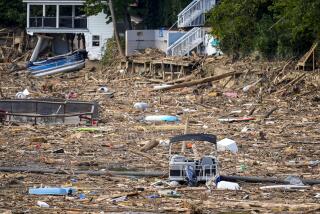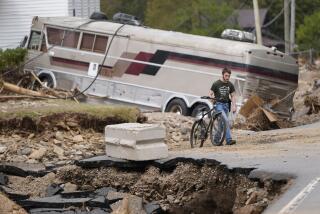Half a Million Try to Escape Bonnie’s Wrath
- Share via
MOREHEAD CITY, N.C. — More than half a million people fled the sea shore Tuesday, from Murrells Inlet, S.C., to the Chesapeake Bay as Hurricane Bonnie, a storm almost as large as the South itself, gathered strength and whirled its way toward land.
Like a scene from some end-of-the-world movie, cars were bumper-to-bumper on roads leading inland, after officials issued strict evacuation orders for residents of North Carolina’s Outer Banks and warned everyone in the region that this is a storm not to be trifled with.
“They are not playing,” said Becky Stonerock, a clerk at a Kroger’s grocery store just outside Raleigh. “This is serious.”
Though Raleigh is well inland, predictions for Bonnie were so ominous that few people in the Southeastern coastal states felt safe. A Category 3, on a scale of 1 to 5, the storm could plow far inland and cause extensive damage.
That’s why Stonerock was jumping all afternoon Tuesday, as customers swept the shelves in her store for bottled water, canned foods and batteries, many openly predicting the worst.
“Anybody who does not abide by the mandatory evacuation, our law enforcement has been instructed to ask them their next of kin,” South Carolina Gov. David Beasley said.
Virginia Gov. James S. Gilmore declared a state of emergency, authorizing communities to order evacuations. And about 60 Navy ships at Norfolk, Va., were instructed to leave port and ride out the storm 300 miles at sea.
Shelters were opened for thousands of displaced residents and tourists in South Carolina, North Carolina and Virginia.
Some people talked about Hurricane Fran, which tore through this region in 1996, killing more than 30 people. “I was without electricity during Fran for a week,” Stonerock said. “This time I’m going to be better prepared.”
Packing winds of 115 mph, Bonnie was located late Tuesday less than 200 miles south of Cape Lookout, N.C., pushing northwest at 14 mph. If it continued overnight along its projected path, the storm was expected to reach the Outer Banks today.
By Tuesday night, winds along the outer edge of the storm were already howling, and residents were trembling.
“This is our first hurricane,” said Lynn Kesler, a jittery resident of Atlantic Beach, the 30-mile-long island at the southern tip of this coastal town. “My boss was like, ‘Lynn, get off this island.’ ”
Along with many homeowners, Kesler took refuge with her family--and their pets--in a cramped motel, which had an air of giddy anxiety as the witching hour approached.
“The waiting is terrible,” said her husband, Russ.
Forecasters have been warning about Bonnie’s strength since last weekend, when officials at the Federal Emergency Management Agency decided to keep their regional headquarters in Atlanta open around the clock.
By Tuesday morning, 17 tractor-trailer rigs were on their way to a staging area at Ft. Bragg, N.C., loaded with 45,000 1-liter containers of water, 6,000 blankets, 3,000 cots and 800 tents.
Also on board were 200 emergency generators, some large enough to power a first-aid center if necessary.
Still, many residents passed the hours before Bonnie’s dreaded arrival in a blissful state of denial. Some were loath to cut long-awaited vacations short. Others were fooled by the mild air and sunny skies.
“The weather is beautiful,” said one employee at the Days Inn Ocean Front, in Kill Devill Hills. “The sun is shining. A light breeze.”
Then again, he added, “the waves are different.”
On Monday, the Roxanne Motel in Myrtle Beach, S.C., was full, all 69 rooms occupied by happy vacationers, some prepared to ignore warnings about heavy surf. Virginia and isolated communities in other states had banned swimming in the ocean because of treacherous rip tides spawned by Bonnie, tides that were blamed for three drownings over the weekend.
By Tuesday, however, folks at the Roxanne Motel were finally taking the storm seriously. Most had checked out, and only a handful of employees were left.
“We did this twice in 1996,” said assistant manager Mark Jernigan. “But [we] didn’t receive any damage. I’m really hoping this storm will just go on out to sea and not bother anybody.”
But that seemed a vain hope by nightfall, as winds began to swirl and windows everywhere were being covered with tape and plywood boards.
“It’s going to be a direct hit,” said Kelly Murphrey, a resident of Harkers Island, N.C., who evacuated his family late Tuesday and planned to spend the night in a local restaurant. Anything would be safer than their mobile home directly on the coast, directly in the path of the storm.
“And there’s two hurricanes!” his daughter chimed in.
Indeed, if residents of Southern coastal states didn’t have enough to fear with Bonnie, forecasters were warning about a sister hurricane following in her footsteps. By late Tuesday morning, Hurricane Danielle had formed an eye and swirled itself into a storm that could easily trace the path of Bonnie, according to officials at the National Hurricane Center.
Still, most people were taking it one hurricane at a time Tuesday night. In an orderly fashion, schools closed until further notice, and businesses stayed open on a minute-to-minute basis. The radio crackled with instructions on how to avoid live power lines, how to stay dry, how to stay fed.
The latter was the one concern that dogged Russ Kesler most. Nevermind the high-velocity winds, the unleashed force of nature. As he chain-smoked outside his motel room, Kesler was wondering if he’d packed enough food before leaving home.
“I never have enough food,” he said.
Times staff writer Eric Slater and researcher John Beckham in Chicago contributed to this story.
Updates on the effects of Hurricane Bonnie are available today on The Times’ Web site. Go to: https://www.latimes.com/bonnie
More to Read
Sign up for Essential California
The most important California stories and recommendations in your inbox every morning.
You may occasionally receive promotional content from the Los Angeles Times.













